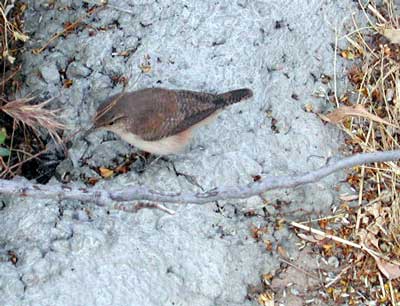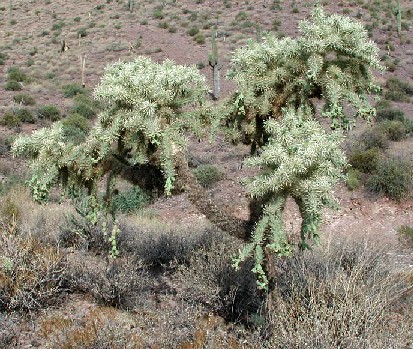Arizonensis
--> Sonoran Desert Naturalist
--> Sonoran Desert
Places --> Goldfield Mountains
Wild Flower Report ¦ Field
Trip Reports ¦ Mammals
¦ Birds ¦ Cacti
¦ Shrubs and Trees
Goldfield Mountains - Apache Junction - Arizona

View looking north from Willow Springs Wash in the Goldfield
Mountains.

A Jeep road runs down through Willow Springs Wash allowing for
easy walking accesss to the area. However, these roads really should be closed
to vehicular traffic because they contribute to uncontrolled erosion,
introduction of exotic weeds, and irresponsible recreationists who leave
rubbish.
|
Introduction
Forget the Dutchman's lost gold. The Goldfield Mountains are a
true botanical treasure that all can easily find and enjoy. They are located
about 8 miles north of Apache Junction via Hwy. 88 (Apache Trail) and stretch
westward for several miles. The scenery is spectacular in part because the
rocks are formed from colorful and porous volcanic rock that also supports many
colorful lichens, mosses and
ferns. Another reason is that cattle are no longer grazed here. Several
jeep roads allow for easy strolling in the desert hills. Hopefully, as the East
Valley grows this area will be protected for future generations to enjoy.
Sponsored Links:
View Larger Map. The overlook
parking area is indicated by the camera icon, Willow Springs Wash by the tree
icon, to the west is Usery
Mountain (table icon). There is camping available at Lost Dutchman
State Park (tent icon). The hiker icon is location of the First Water Trailhead
into the Superstition
Wilderness.
|
Ten naturalists - Native Plant Society and Maricopa Audubon -
gathered on Oct. 5th for a trek down Willow Springs Wash organized by Mike
Plagens for the Phoenix Chapter of ANPS. We began our trek at the Weaver's
Needle Vista, about six miles north of Apache Junction on the Apache Trail. The
parking area and viewpoint are on the east side of the highway, looking out on
the spectacular Superstition Mountains and a perfect view of Weaver's Needle.
Willow Springs Wash passes just to the south of the parking area, which we
followed west through a culvert under the highway and on into the Goldfield
Mountains. Alternately, directly across the highway from the entrance to the
vista is a jeep trail that goes directly down into the Willow Springs wash. The
spectacular and colorful geography is due to the series of volcanoes that
created the Superstitions and the Goldfields some 15-25 MYBP. Yellows, oranges
and brick reds of fused volcanic ash with abundant desert vegetation and
lichens made for wondrous scenery. There are at least five recognized volcanic
calderas in this area including the Willow Springs Caldera, which we hiked
through.
The perimeter of the parking area had a lush hedge of flowering
Golden Alkali Bush (Isocoma acradenia), but we soon discovered that
without the rain harvesting effect of the pavement, that this area was
thoroughly dried and parched: our spotty summer monsoons had completely forgot
the Goldfields and matched the omission with one of our hottest summers on
record. Prickly pears and even the creosote bush were shriveled and yellowed.
We took our adventure in stride, however, recognizing that this is what desert
survival really means. The hardies of desert plants become largely dormant for
extended periods if necessary.
Despite the extreme dryness we found some interesting plants in
bloom. Willows and cottonwoods in the wash itself were stressed for sure, but
green enough for us to know that they were tapping deep moisture flowing down
from the Superstitions to the east. Sweet Bush (Bebbia juncea) and
Golden Aster (Heterotheca villosa) were in bloom and gathering
butterflies (6 spp.) to their offer of nectar. Other bloomers found were
Wright's Buckwheat (Eriogonum wrightii), Three-Awn (Aristida purpurea),
Waterweed (Baccharis sergiloides) and Indian Root (Aristolochia watsoni).
We found several other interesting plants that were without blooms, including Carlowrightia
arizonica and Crossosoma bigelovii.
Field Trip: Nov. 25th, 2006
Patches of Engelmann Prickly Pear (Opuntia engelmannii)
are definately on the decline in this area - possibly the result of cessation
of intense cattle grazing - one sign of this decline are many dense colonies of
Cochineal Scale (Dactylopius sp.) on the cactus pads. Here is my
hypothesis: When cattle were were grazed at high densities prickly pear
populations increased because they are generally avoided by foraging cattle at
the expense of palatable herbs and grasses. Now the density of prickly pear is
high allowing for rapid spread of scales while at the same time
cattle-preferred plants are on the come back competing with prickly pears for
water and sunlight weakening them to attack by scales and other insects and
diseases.
Threats to Goldfield Mountains Ecology & Biodiversity
-
Invasion of exotic invasive weeds:
-
Fountain Grass -- Pennisetum setaceum -- large numbers of these
robust perennial grass plants are growing in Willow Springs Wash and even up
side drainages. They are competing with native Deer Grass (Muhlenbergia
rigens). I found many young fountain grass but just a few remaining mature
Deer Grass -- Muhlenbergia rigens.
-
Tamarisk;Salt
Cedar -- Tamarix pentandra -- few washes and river ways in the
southwestern United States have escaped this invasive weedy shrub/tree.
-
Erosion caused by ORV's.
-
Rock climbers: Rhyolite slopes are soft and easily erodable - but also have
high plant diversity thus boots and tools damage easily.
-
Wildfires caused by careless visitors but also lightning sparked fires carried
along Red Brome Grass (yet another exotic-invasive).
Birds
Common birds generally in order of abundance:
-
Verdin
--Sp,Su,F,W Tiny birds, barely larger than a hummingbird. Drab gray brown with
a majestic yellow head.
-
Mourning Dove
-- Sp,Su,F,W
-
Rock
Wren
-- Sp,Su,F,W
-
Gila Woodpecker
-- Sp,Su,F,W
-
Phainopepla
-- F,W,Sp
-
Black-throated
Sparrow
-- Sp,Su,F,W Lovely birds with a jet-black throat and bib contrasted by bright
white eye brows. Beautiful singers.
-
House
Finch
-- Sp,Su,F,W
-
Canyon
Towhee
-- Sp,Su,F,W
-
Cactus Wren
-- Sp,Su,F,W
-
Brown-crested Flycatcher -- Myiarchus tyrannulus
-- Sp,Su
-
Gambel's Quail
-- Sp,Su,F,W
-
Ruby-crowned Kinglet -- Regulus calendula
-- F,W
-
Black-tailed Gnatcatcher -- Polioptila melanura
-- Sp,Su,F,W
-
Curve-billed Thrasher -- Sp,Su,F,W
|
Rock Wrens forage for spiders and insects in and around
boulders.
|
Mammals
In order of Abundance:
-
Audubon's
Cottontail
-- Common.
-
Coyote -- These animals often forage for rodents, rabbits, stray cats and fruit
in the surrounding neighborhoods.
-
White-throated Woodrat
--
-
Javelina
--
|
Woodrats build huge mounds from twigs and cactus pieces.
|
Cacti
In order of general abundance:
-
Fishhook
Pincushion (Mammalaria grahamii)
-
Buckhorn
Cholla (Opuntia acanthocarpa) --
-
Chain-fruit
Cholla (Opuntia fulgida) -- Also known as Jumping Cholla.
-
Saguaro
Cactus (Carnegiea giganteus) -- many of the living saguaros
have their lower portions brown and non-photosynthetic. This is due to
scorching by a range fire some years ago.
-
Hedgehog
Cactus (Echinocereus engelmannii) --
-
Teddy
Bear Cholla (Opuntia bigelovii) -- several patches upon the
hillsides
-
Prickly
Pear -- Opuntia engelmannii
-- probably hangers on from the cattle grazing days.
-
Compass
Barrel Cactus (Ferocactus cylindraceus) -- Spines tinged
with red and yellow.
-
Desert Christmas Cactus (Opuntia leptocaulis) -- these will
become easier to find as the thimble-sized fruits change to bright red through
January and February
|
A Chain-fruit Cholla growing in the Goldfield Mts, Arizona.
|
Shrubs and Trees
More common species listed first.
This long list of frequent shrubs is evidence of the high biodiversity.
-
Triangle-leaf Bursage (Ambrosia deltoidea) -- Leafless after
periods of drought or hard frost.
-
Foothills
Palo Verde (Cercidium microphyllum) --
-
Jojoba
(Simmondsia chinensis) -- large shrubs with leathery, dark olive
green leaves
-
Wolfberry
(Lycium
spp.) --
-
Ocotillo
(Fouquieria splendens) --
-
Salt Cedar
(Tamarix pentandra) --
-
Desert Trumpet -- Eriogonum inflatum
--
-
White
Ratany -- Krameria grayi
-- purplish cast to woody stems
-
Brittle Bush
(Encelia farinosa) -- Leafless after drought or frost. Leaves are
silvery green and flowers are bright yellow.
-
Fairy Duster (Calliandra eriophylla) --
-
Flat-topped Buckwheat (Eriogonum fasciculatum) --
-
Twinberry
(Menodora scabra) --
-
Brickle
Bush (Brickelia coulteri)--
-
Joint
Fir -- Ephedra aspera
--
-
Sweet
Bush (Bebbia juncea) --
-
Desert
Senna (Senna covesii) --
-
Ironwood
(Olneya tesota) --
-
Bigelow
Four O'Clock(Mirabilis bigelovii) --
-
Canyon Ragweed
(Ambrosia ambrosioides) - mostly along the washes
-
Desert Mistletoe (Phoradendron californicum) - Parasitic
shrub growing upon various desert trees including Palo Verde and Ironwood.
-
Desert
Rock Pea (Lotus rigidus) -- growing among rocks or boulders.
-
Globe Mallow (Sphaeralcea ambigua) - peach colored blooms
after periods of rain otherwise it is difficult to find
-
Velvet
Mesquite -- Prosopis velutina
- mostly along the washes
-
Cat
Claw Acacia(Acacia greggiii) - also mostly along the washes
-
Desert
Hackberry (Celtis pallida) - along the washes
-
Graythorn (Zizyphus obtusifolia) -- wash
-
Desert
Broom (Baccharis sarothroides) - another wash shrub
-
Janusia
(Janusia gracilis) - a twisty, viney plant
-
Lance-leaf Ditaxis (Argythamnia lanceolata)
-
Shrubby Bedstraw (Galium stellatum) -- growing amongst rocks
-
Goodding's
Willow (Salix goodingii) -- amazingly yes -- along Willow
Springs Wash
-
Fremont
Cottonwood (Populus fremontii) -- a few stressed trees along
Willow Springs Wash - some appear to have had better days and are now just
hanging on.
-
Trixis (Trixis californica) --
-
Creosote
Bush (Larrea tridentata) -- dark evergreen shrub with shiny,
resinous leaves and dark wirey twigs.
-
Turpentine Bush -- Ericameria laricifolia
-
Turpentine
Broom -- Thamnosma montana
-- this is the furthest southeast that I have encountered this shrub
-
Desert Milkweed (Ascepias subulata) -- sandy areas smooth
greenish stems w/o leaves
-
Hop
Bush (Dodonaea viscosa)
-
Alkali
Goldenweed (Isocoma acradenia)
-
Antelope Horns (Asclepias asperula) -- lower than usual elevation
-
Ragged
Rock Flower (Crossosoma bigelovii) -- in the shade of narrow
ravines or north facing slopes
-
Bernardia
(Bernardia incana) -- in the shade of narrow ravines or north facing
slopes
-
Goldeneye (Viguiera deltoidea)
-
Rock
Echeveria (Dudleya saxosa) - succulent on porous north-facing
slopes
|
Sponsored Links:

A Sketch of Crossosoma growing in the Goldfield Mts,
Arizona. The flowers appear in early spring. Sara Orange-tip butterflies are
likely to be found at the same time. The butterflies are yellow with orange.
|

Spring Wildflowers - (observed Feb 21, 1998)
Sonoran Desert Naturalist Home
Page
Desert Places
Field Guide
Copyright
Michael J. Plagens, 1999-2008






